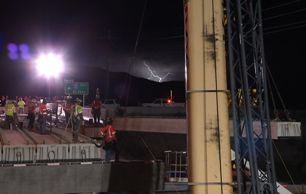Residents of two rural Southern Arizona towns are celebrating the reopening of a freeway bridge that had been severely damaged earlier this year after two semi-trucks caught fire during an accident. The bridge over Interstate 10 was demolished and rebuilt in only six months, alleviating a 10-mile detour for residents on either side of the freeway.


Located 40 miles east of Tucson, the Mescal Road/J-Six Ranch Road Bridge was originally built in 1958 using steel girders, which warped due to the intense heat of the March 15 fire.
Because crews were already working on a new traffic interchange just five miles from the accident site, demolition occurred just 24 days after the fire, says Jackie Watkins, senior resident engineer with the Arizona Dept. of Transportation. “They had all the equipment and subcontractors that could quickly mobilize,” she adds. The demolition also coincided with an already-scheduled freeway closure, so ADOT took advantage of that closure to perform the demolition.
The Federal Highway Administration authorized $955,000 in emergency funds to replace the bridge, and the project was placed out for bid in May. The contract was awarded in a fast-track selection process to Chino Valley, Ariz.-based Vastco Inc.
The new 216-ft bridge was designed by ADOT using 35 pre-cast concrete box girders. At the suggestion of the contractor, the outside support beams were delivered with attached precast bridge barriers to save time during installation by reducing the need for freeway lane closures, Watkins says.
Delivery of long lead-time items such as the box girders and bearing pads was essential, says Steve Rogers, Vastco’s chief estimator. A key difference in the job was setting the bridge on the bearing pads and completing it prior to testing. “Normally you wouldn’t do that, but it was the only way we could make this schedule,” Rogers says.
An existing pedestrian bridge built adjacent to the old bridge survived the fire and will be tied into the new bridge structure. “We had to jack up the abutment in one of the piers to replace the bearing pads on it because the fire had melted them.”
While crews are still painting and installing guard rails, the new bridge opened a few hours ahead of schedule on Sept. 19. There were no bonuses for early completion, but the contractor avoided $10,000 a day in liquidated damages had the project been delivered late.



Post a comment to this article
Report Abusive Comment